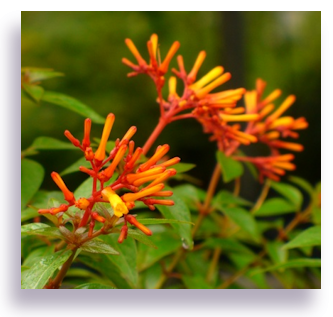 This semi∼hardy shrub is said by some to grow to about 5 feet. Down south, this thing grows to over 15 feet, and fairly quickly. A beautifully canopied shrub, small tree, it must be shaped and pruned, and can be used as a hedge if you let it fill out. That is usually the way I see it treated down here.
This semi∼hardy shrub is said by some to grow to about 5 feet. Down south, this thing grows to over 15 feet, and fairly quickly. A beautifully canopied shrub, small tree, it must be shaped and pruned, and can be used as a hedge if you let it fill out. That is usually the way I see it treated down here.
Fire bush, or Firecracker shrub, Hummingbird bush, or even called Scarlet bush; is happy in shade or even mostly sunny locations. It does flower more when given a sunnier location. This hamelia species also likes a moist soil, with added loam. It should be fertilized in early spring, with a fruit and nut fertilizer spike, and once again in midsummer.
Firecracker bush grows very fast with proper attention paid to it, and has a slight spreading habit at the base. You can prune these off and use the semi∼woody cuttings for propagation, or just toss them on the compost pile.
Firecracker bush will need frost protection when first put out, and is grown in zones 9, 10 and 11. After the plant establishs itself it will recover from the light frosts of zone 9 and bounce back in full bloom. Often found in semi∼swampy areas and hammocks, in Florida, it can grow as high as 12 feet in the wild. There are two varieties of firecracker shrub, and the species Hamelia patens is the one found in the glades.
Hamelia patens has bright, hot pink to lightly tinged purple red stems that hold up the tubular red to reddish yellow flowers. The leaves are hairy. Hamelia patens var. glabra is the South American version, and has yellow flowers. It is often found in nurseries in South Florida. The berries of both are said to be edible, and the plant also propagates easily from the seeds, if allowed to ripen and drop off the plants. The sap of the bush was once used to stop bleeding.
After a few years, both species will grow a thick trunk, about 3 to 4 inches in diameter, and if allowed, will grow upwards as well as outwards. A few people even train it to tree standard form. Firebush attracts many bees, butterflies and hummingbirds.
This past summer of 2013, ours has taken off like wildfire. We have had the wettest summer in many years, and I have also remembered to fertilize it on a regular basis. It has easily grown over 4 feet out in width (all around) and upwards of about two feet. Now that I see it putting on size, I take even better care of it, because it is the first shrub that the Zebra Longwings and Gulf Fritillaries come to feed on in the mornings. And when the Monarchs are coming through, they do not pass it up either.
The Firecracker bush also attracts skippers with big black eyes, beautiful metallic green and blue bees, and even a Giant Swallowtail or two. The honeybees make an attempt, but it is futile, the slender flower's tube is too long for them to receive any nectar. But you can't blame them for trying.
Tags: hamelia, firebush, hamelia, firebush, firecracker shrub, fire bush, hamelia,

